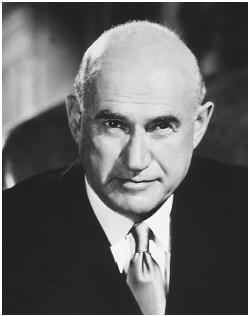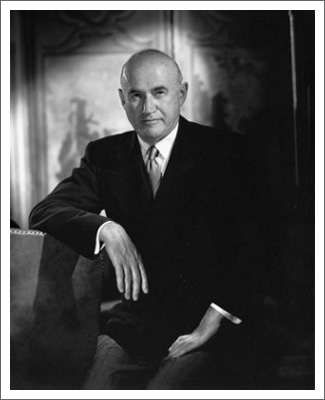<Back to Index>
- Physician Frederick Fuller Russell, 1870
- Film Producer Samuel Goldwyn, 1879
- King of Poland John III Sobiesky, 1629
PAGE SPONSOR


Samuel Goldwyn (August 17, 1879 – January 31, 1974) was an American film producer, and founding contributor executive of several motion picture studios.
Goldwyn was born Schmuel Gelbfisz in Warsaw, Congress Poland, Russian Empire to a Hasidic, Polish Jewish family. At an early age he left Warsaw on foot and penniless. He made his way to Birmingham, England, where he remained with relatives for a few years using the name Samuel Goldfish. In 1898, he emigrated to the United States, but fearing refusal of entry, he got off the boat in Nova Scotia, Canada, before moving on to New York in January 1899. He found work in upstate Gloversville, New York, in the bustling garment business. Soon his innate marketing skills made him a very successful salesman. After four years, as vice president for sales, he moved back to New York City.
In 1913, Goldfish along with his brother-in-law Jesse L. Lasky, Cecil B. DeMille, and Arthur Friend formed a partnership, The Jesse L. Lasky Feature Play Company, to produce feature length motion pictures. Film rights for the stage play The Squaw Man were purchased for $4000 and Dustin Farnum was hired for the leading role. Shooting for the first feature film made in Hollywood began on December 29, 1913.
In 1914, Paramount was a film exchange and exhibition corporation headed by W.W. Hodkinson. Looking for more movies to distribute, Paramount signed a contract with the Lasky Company on June 1, 1914 to supply 36 films per year. One of Paramount's other suppliers was Adolph Zukor's Famous Players Company. The two companies merged on June 28, 1916 forming The Famous Players - Lasky Corporation. Zukor had been quietly buying Paramount stock and two weeks prior to the merger became president of Paramount Pictures Corporation and had Hodkinson replaced with Hiram Abrams, a Zukor associate.
With the merger, Zukor became president of both Paramount and Famous Players - Lasky, with Goldfish being named chairman of the board of Famous Players - Lasky, and Jesse Lasky first vice president. After a series of conflicts with Zukor, Goldfish resigned as chairman of the board, and as member of the executive committee of the corporation on September 14, 1916. Goldfish was out as an active member of management, although he still owned stock and was a member of the board of directors. Famous Players - Lasky would later become part of Paramount Pictures Corporation, and Paramount would become one of Hollywood's major studios.
In 1916, Goldfish partnered with Broadway producers Edgar and Archibald Selwyn, using a combination of both names to call their movie making enterprise the Goldwyn Pictures Corporation. Seeing an opportunity, Samuel Gelbfisz then had his name legally changed to Samuel Goldwyn, which he used for the rest of his life. The Goldwyn Company proved moderately successful but it is their "Leo the Lion" trademark for which the organization is most famous. Eventually the company was acquired by Marcus Loew and his Metro Pictures Corporation but by then Samuel Goldwyn had already been forced out by his partners and was never a part of the new studio that became Metro-Goldwyn-Mayer. After his departure from Goldwyn Pictures Corporation, he established Samuel Goldwyn Inc., eventually opening Samuel Goldwyn Studio on Santa Monica Blvd. in West Hollywood.
For 35 years, Goldwyn built a reputation in filmmaking and an eye for
finding the talent for making films, although, contrary to some
erroneous claims, he did not discover actor Gary Cooper. He used director William Wyler for many of his productions and hired writers such as Ben Hecht, Sidney Howard, Dorothy Parker, and Lillian Hellman.
(According to legend, at a heated story conference Goldwyn scolded
someone — in most accounts Mrs. Parker — who recalled he had once been a
glove maker and retorted: "Don't
you point that finger at me. I knew it when it had a thimble on it!"
Another time, when he demanded a script that ended on a happy note, she
said: "I know this will come as a shock to you, Mr. Goldwyn, but in all
history, which has held billions and billions of human beings, not a
single one ever had a happy ending.") For more than three decades, Goldwyn made numerous successful films and received Best Picture Oscar nominations for Arrowsmith (1931), Dodsworth (1936), Dead End (1937), Wuthering Heights (1939), and The Little Foxes (1941). The leading actors in several of Goldwyn films were also Oscar-nominated for their performances. Throughout the 1930s, Goldwyn released all his films through United Artists, but beginning in 1941, and continuing almost through the end of his career, Goldwyn released his films through RKO Radio Pictures. In 1946, the year he was honored by the Academy of Motion Picture Arts and Sciences with the Irving G. Thalberg Memorial Award, Goldwyn's drama The Best Years of Our Lives, starring Myrna Loy, Fredric March, Teresa Wright and Dana Andrews, won the Academy Award for Best Picture. In the 1950s Samuel Goldwyn turned to making a number of musicals including the 1955 hit Guys and Dolls starring Marlon Brando, Jean Simmons, Frank Sinatra, and Vivian Blaine. This was the only independent film that Goldwyn ever released through MGM. (Goldwyn had previously made several musicals starring Eddie Cantor and Danny Kaye, as well as 1938's The Goldwyn Follies.) In his final film, made in 1959, Samuel Goldwyn brought together African American actors Sidney Poitier, Dorothy Dandridge, Sammy Davis, Jr. and Pearl Bailey in a film rendition of the George Gershwin opera, Porgy and Bess. Released by Columbia Pictures,
the film was nominated for three Oscars, but won only one. It was also
a critical and financial failure, and the Gershwin family reportedly
disliked the film and eventually pulled it from distribution. The
reception of the film was a huge disappointment to Goldwyn.
Goldwyn was married to Blanche Lasky, a sister of Jesse, from 1910 to 1915. In 1925, he married actress Frances Howard to whom he remained married for the rest of his life. Their son, Samuel Goldwyn, Jr., would eventually join his father in the business. Goldwyn's relatives include Fred Lebensold,
an award winning architect (best-known as the designer of multiple
concert halls in Canada and the United States). Fred was the son of
Sam's younger sister, Manya (who, despite the best efforts of Sam and
his brother Ben in 1939 and 1940, could not be extricated from the Warsaw Ghetto and perished in the Holocaust).
Samuel
Goldwyn's will created a multi-million dollar charitable foundation in
his name. Among other endeavors, the Samuel Goldwyn Foundation funds the Samuel Goldwyn Writing Awards, provided construction funds for the Frances Howard Goldwyn Hollywood Regional Library, and provides ongoing funding for the Motion Picture & Television Country House and Hospital.
Several
years after the Sr. Goldwyn's death, his son, Samuel Goldwyn Jr.,
initiated an independent film and television distribution company
dedicated to preserving the integrity of Goldwyn's ambitions and work.
The rights to the classic Goldwyn library (among other pre-1996 Goldwyn
company holdings) are now held by MGM.
Samuel Goldwyn died at his home in Los Angeles in 1974 from natural causes, at the probable age of 94. He was interred in the Forest Lawn Memorial Park Cemetery in Glendale, California. In the 1980s, Samuel Goldwyn Studio was sold to Warner Bros. There is a theater named for him in Beverly Hills and he has a star on the Hollywood Walk of Fame at 1631 Vine Street.